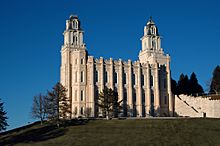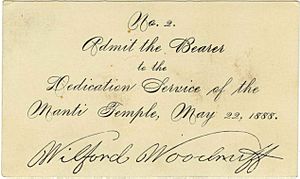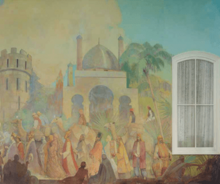Manti Utah Temple facts for kids
| Manti Utah Temple | |||||||||||||||||||||||||||||||||||||||||||||||
|---|---|---|---|---|---|---|---|---|---|---|---|---|---|---|---|---|---|---|---|---|---|---|---|---|---|---|---|---|---|---|---|---|---|---|---|---|---|---|---|---|---|---|---|---|---|---|---|
 |
|||||||||||||||||||||||||||||||||||||||||||||||
| Number | 3 | ||||||||||||||||||||||||||||||||||||||||||||||
| Dedicated | Quick facts for kids May 21, 1888 byLorenzo Snow |
||||||||||||||||||||||||||||||||||||||||||||||
| Site | 27 acres (10.9 hectares) | ||||||||||||||||||||||||||||||||||||||||||||||
| Floor area | 100,373 sq ft (9,325 m2) | ||||||||||||||||||||||||||||||||||||||||||||||
| Height | 179 ft (55 m) | ||||||||||||||||||||||||||||||||||||||||||||||
| Preceded by | Logan Utah Temple | ||||||||||||||||||||||||||||||||||||||||||||||
| Followed by | Salt Lake Temple | ||||||||||||||||||||||||||||||||||||||||||||||
| Official website: https://www.churchofjesuschrist.org/temples/details/manti-utah-temple • News & images | |||||||||||||||||||||||||||||||||||||||||||||||
|
|||||||||||||||||||||||||||||||||||||||||||||||
|
Manti Temple
|
|
| Location | N edge of Manti, on U.S. 89, Manti, Utah |
|---|---|
| Area | 4.3 acres (1.7 ha) |
| Built | 1877 |
| Architect | William H. Folsom |
| Architectural style | Gothic Revival, French Renaissance Revival, Second French Empire, Colonial architectural |
| NRHP reference No. | 71000854 |
| Added to NRHP | August 12, 1971 |
The Manti Utah Temple (formerly the Manti Temple) is the fifth constructed temple of the Church of Jesus Christ of Latter-day Saints. Located in the city of Manti, Utah, it was the third Latter-day Saint temple built west of the Mississippi River, after the Mormon pioneers trekked west. (The St. George and Logan Utah temples preceded it.) The Manti Temple was designed by William Harrison Folsom, who moved to Manti while the temple was under construction. The temple dominates the Sanpete Valley and can be seen from many miles. Like all Latter-day Saint temples, only church members in good standing may enter. It was previously one of only two remaining Latter-day Saint temples in the world where live portrayal was used in the endowment ceremony (the other was the Salt Lake Temple). All other temples use a film in the presentation of the endowment, a practice that will also be used in Manti beginning in 2024 following renovation. It is an early pioneering example of four rooms representing the journey of life.
Contents
History
Church president Brigham Young announced the decision to build a temple in Manti on June 25, 1875, and dedicated the site on April 25, 1877. On the day of the dedication, Young took Warren S. Snow to the southeast corner of the temple site and told him, "Here is the spot where the Prophet Moroni stood and dedicated this piece of land for a Temple site, and that is the reason why the location is made here, and we can't move it from this spot."
The Salt Lake Temple had been announced in 1847, but construction was still underway and not finished until 1893. The Manti Temple was built, along with the St. George and Logan temples, to satisfy the church's immediate need for these structures. The site for the temple was the Manti Stone Quarry, a large hill immediately northeast of town. Early pioneer settlers in the area prophesied that this would be the site of a temple. When Young announced the building of the temple, he also announced that the 27-acre (110,000 m2) plot would then be known as "Temple Hill."
The temple was completed in 1888, and a private dedication was held on May 17, 1888, with a prayer written by Wilford Woodruff. Three public dedications were held on May 21–23, 1888, and were directed by Lorenzo Snow.
The Manti Temple was the location of the Holy of Holies until the Salt Lake Temple was dedicated. The room was then used for sealings until it was closed in the late 1970s.
A 1966 study found that 52 percent of temple work was being done in either the Salt Lake, Logan, or Manti temples, even though there were 13 operating temples by that time. This led to the building of the Ogden and Provo temples to relieve the strain on the older pioneer-era temples.
Art
The temple includes murals by several Latter-day Saint artists, including C. C. A. Christensen (Creation Room, 1886–87), Minerva Teichert (World Room, 1947, assisted by Frank Stevens), Robert L. Shepherd (Garden Room, 1946), John Hafen, J. B. Fairbanks, and Dan Weggeland. Some of the original murals, having been damaged and unable to be saved, had sail canvas placed over them in order for new murals to be painted. For instance, Weggeland's Garden Room mural still exists underneath Shepherd's original.
The temple is also filled with other paintings. The mix of paintings has changed over time, but among the paintings originally intended for the building include two by Christensen. One of those depicts the hill where the temple would later sit with a Native American encampment in the foreground, with the other being the temple itself and its landscaped grounds.
Minerva Teichert's work on the World Room
Minerva Teichert was commissioned to create the World Room mural by church president George Albert Smith. She was the first woman in the church to be commissioned to paint. She was given $4,000 for the project. At the time of creating the murals, Teichert was suffering from the effects of lead poisoning, which can cause difficulties including nausea, abdominal pain, and optic neuritis. She created a deadline of a month to finish the project, and would occasionally give a whole day just to a specific section. She was known to ask for prayers for her health and would pray extra during times of difficulty working on the painting.
Frank Stevens provided assistance with moving scaffolding and creating sketches under Teichert’s supervision. Much of the work of painting took place high up on scaffolding stretching up to 28 feet, and both Stevens and Teichert faced fears about working so high. While working on the Tower of Babel scene, she fell off a scaffold and hurt her arm. After consulting a doctor, she resumed work a few hours later, out on the same ledge as before. The mural features 120 figures, Techert referred to it as a “great pageant.” At the end of the process, she related that she worked ‘very fast’ and that “No mural decorator in America ever beat that – nearly 4,000 square feet (370 m2) in 23 days.” More work remained on the temple, and she returned at different times to continue touching up the mural, which ended up being about 28 days in total, with the last of the touch ups ending in March 1948.
Renovations
The Manti Temple has undergone various remodeling and renovations. Construction of a great stone stairway leading up the hill to the west temple doors began in 1907. In 1935, the temple was fully lit at night for the first time. In 1940, the stone stairs were removed and work began to beautify the grounds. Between 1944 and 1945 the annex, chapel, kitchen, Garden Room, and men's and women's areas were remodeled. There was once a tunnel beneath the east tower of the temple through which wagons and cars could pass, but it was closed off in the 1960s. Because of that, it was once said that "the Manti Temple is the only temple you can go through without a recommend."
In 1981, church officials decided that the interior of the temple needed extensive remodeling. The renovation took four years, during which murals and original furniture were restored, offices were enlarged and remodeled, a separate door was made to the baptistry, water and weather damage were repaired, an elevator installed, and locker rooms were improved among many other projects. In June 1985, Gordon B. Hinckley, then a counselor in the First Presidency, directed the rededication ceremonies. Exterior preservation efforts have also occurred since that time.
Removal of murals
In March 2021, the First Presidency announced significant renovations for the Manti and Salt Lake temples, including ending the live endowment. The decision to end live endowments was rooted in the need for the temples to offer more sessions throughout the day and in different languages; live endowment sessions were only available in English in either temple. To accommodate these changes, it was announced the interiors of the temples would be reconfigured for single-room, multimedia-based endowment sessions as done in other temples, which would also involve the removal of historic artwork in the temples, including Minerva Teichert's murals in the Manti temple. A week following the initial announcement, the church issued an updated statement on the plans for the Manti Temple, stating it would consult with art preservationists about the best way to remove part or all of the Teichert murals, which are canvas affixed to plaster, and preserve them for public display.
On May 1, church president Russell M. Nelson announced that upon reconsideration, although the temple would be updated to use film, care would be taken to preserve the temple's interior, including its art. To increase temple capacity for the area, he announced that an additional temple would be built in Ephraim, Utah.
Style
The Manti Temple combines the Gothic Revival, French Renaissance Revival, Second French Empire, and Colonial architectural styles. The temple has 100,373 square feet (9,325 m2) of floor space, eight sealing rooms, four ordinance rooms, and a Celestial room. The exterior is made of fine-textured, cream-colored oolite limestone from quarries in the hill on which the temple stands. The two towers of the temple are 179 feet (55 m) tall, and the open center spiral staircases inside the towers are marvels of pioneer ingenuity.
Temple presidents
Notable temple presidents include: Daniel H. Wells (1888–91); Anthon H. Lund (1891–93); John D. T. McAllister (1893–1906); Robert D. Young (1933–43); Jack H. Goaslind Jr. (2000–03); and Ed J. Pinegar (2009–12). As of February 2024, the temple president and matron are Richard W. and Linda N. Wheeler.
See also
 In Spanish: Templo de Manti para niños
In Spanish: Templo de Manti para niños
|
Temples in Utah () Wasatch Front Temples
Temples along the Wasatch Front ()
|
- The Church of Jesus Christ of Latter-day Saints in Utah
- Comparison of temples of The Church of Jesus Christ of Latter-day Saints
- List of temples of The Church of Jesus Christ of Latter-day Saints
- List of temples of The Church of Jesus Christ of Latter-day Saints by geographic region
- Mormon Miracle Pageant
- Temple architecture (Latter-day Saints)





